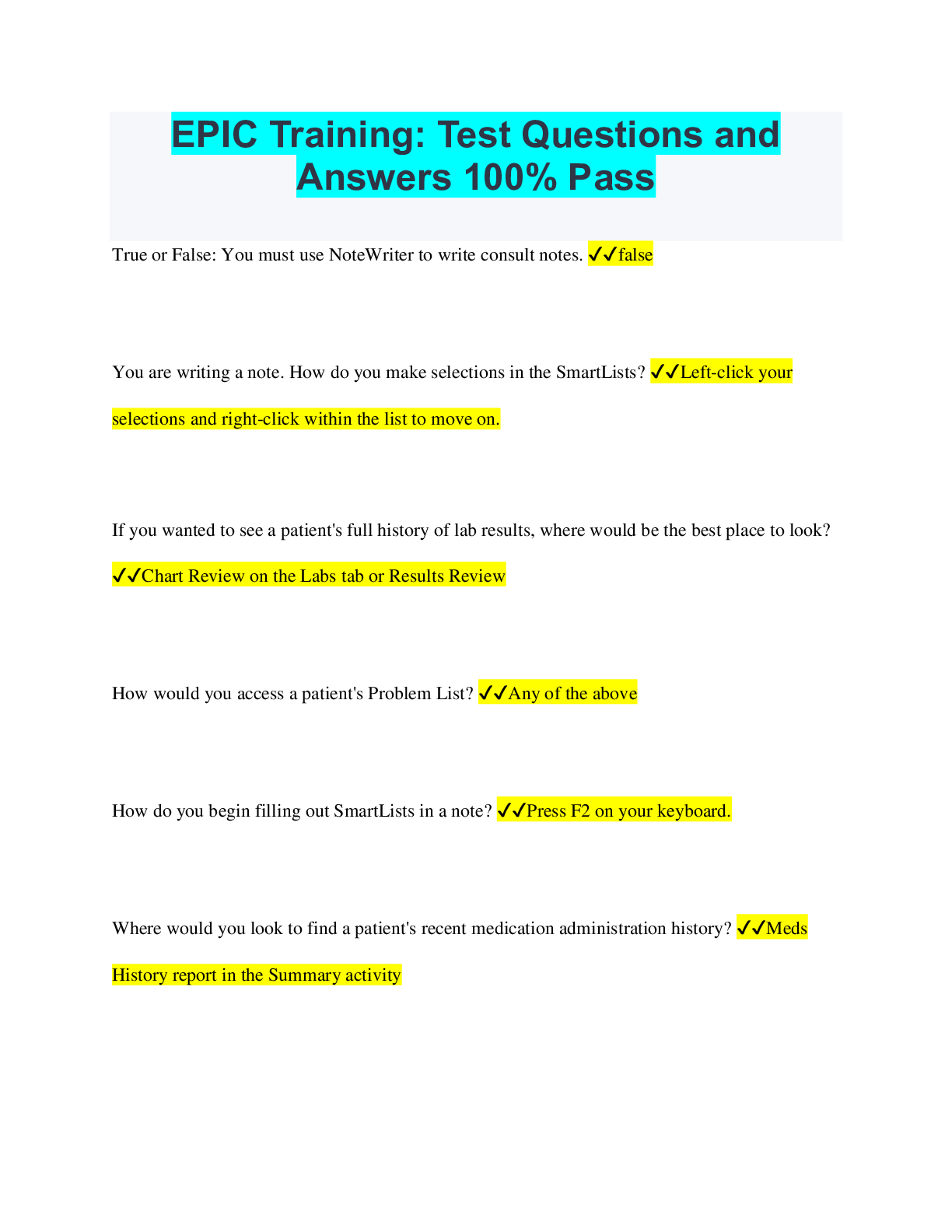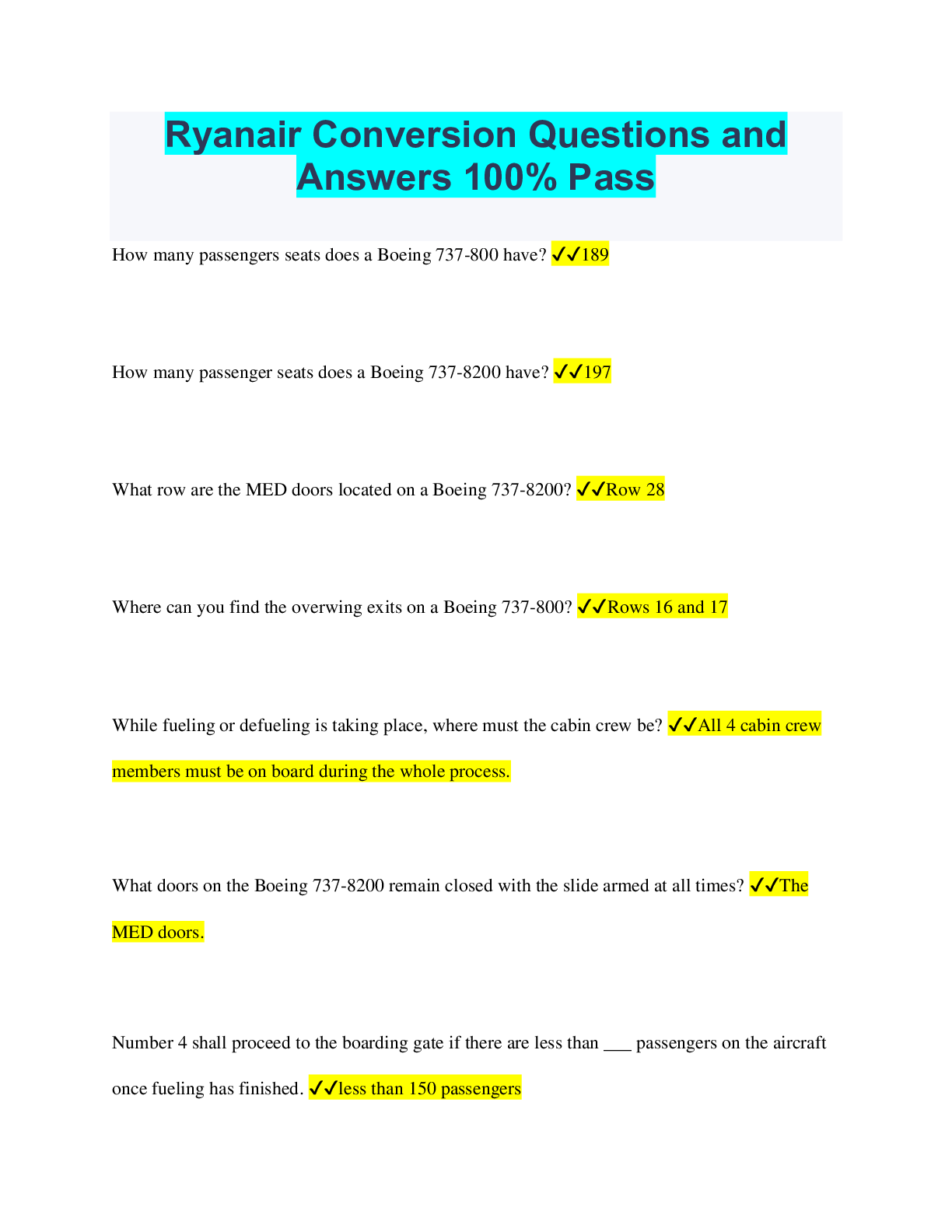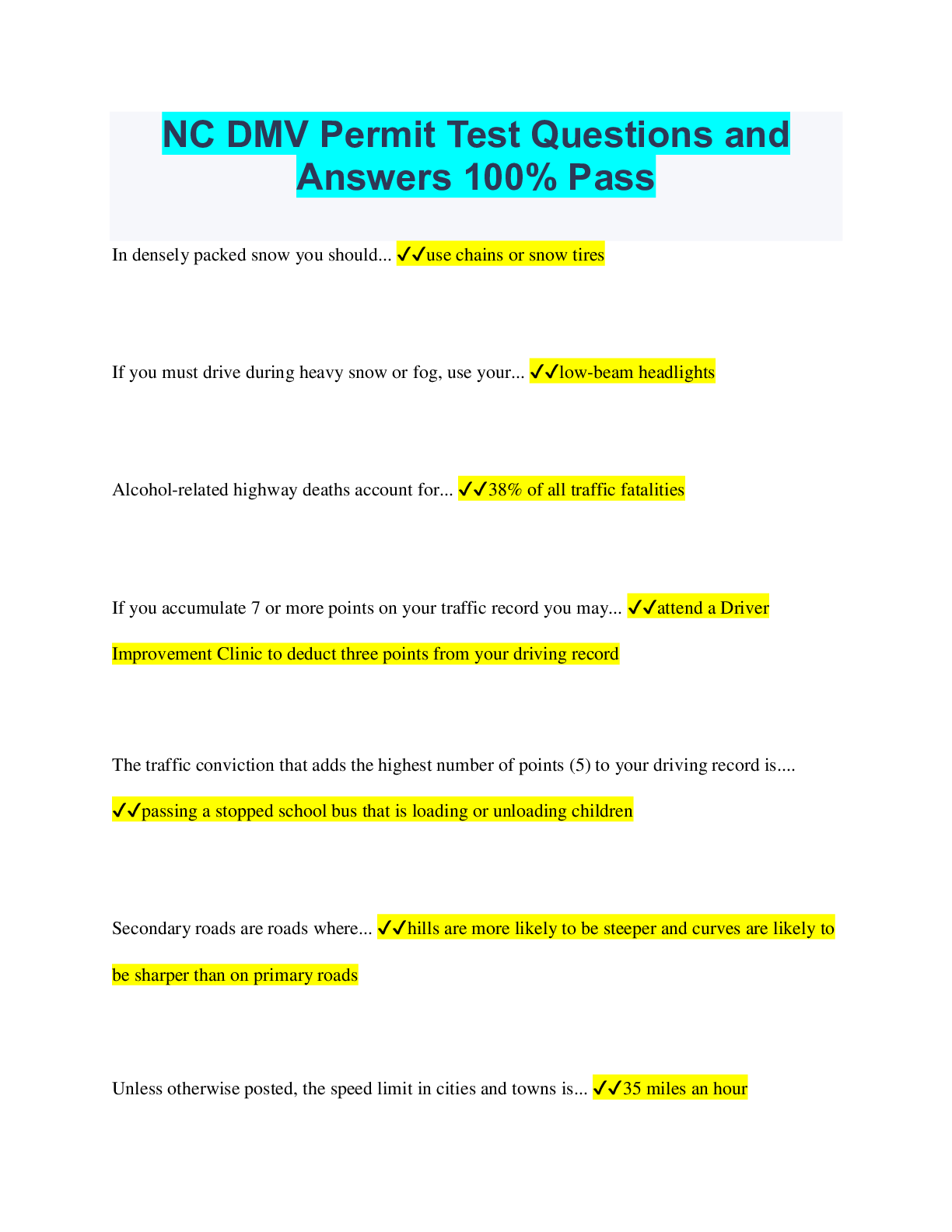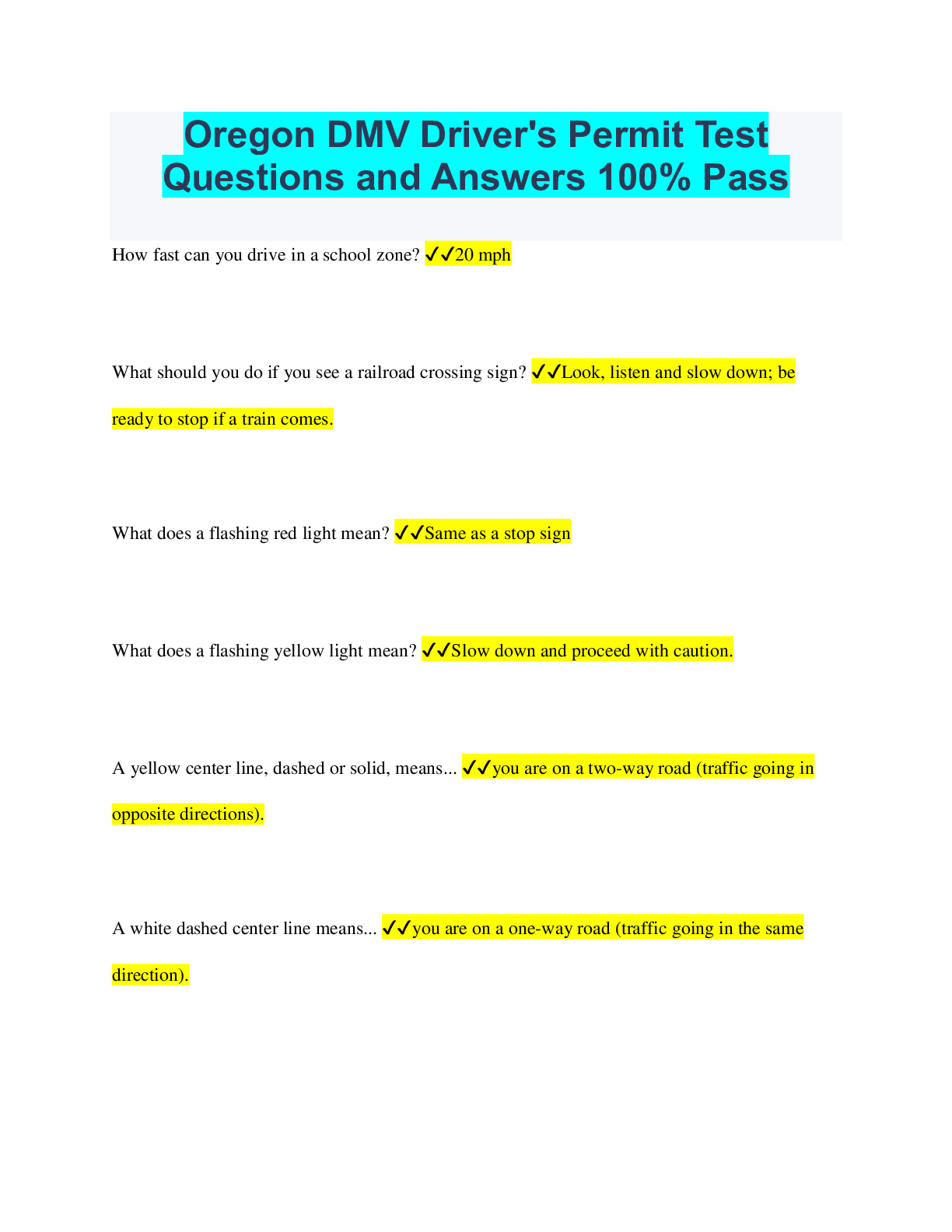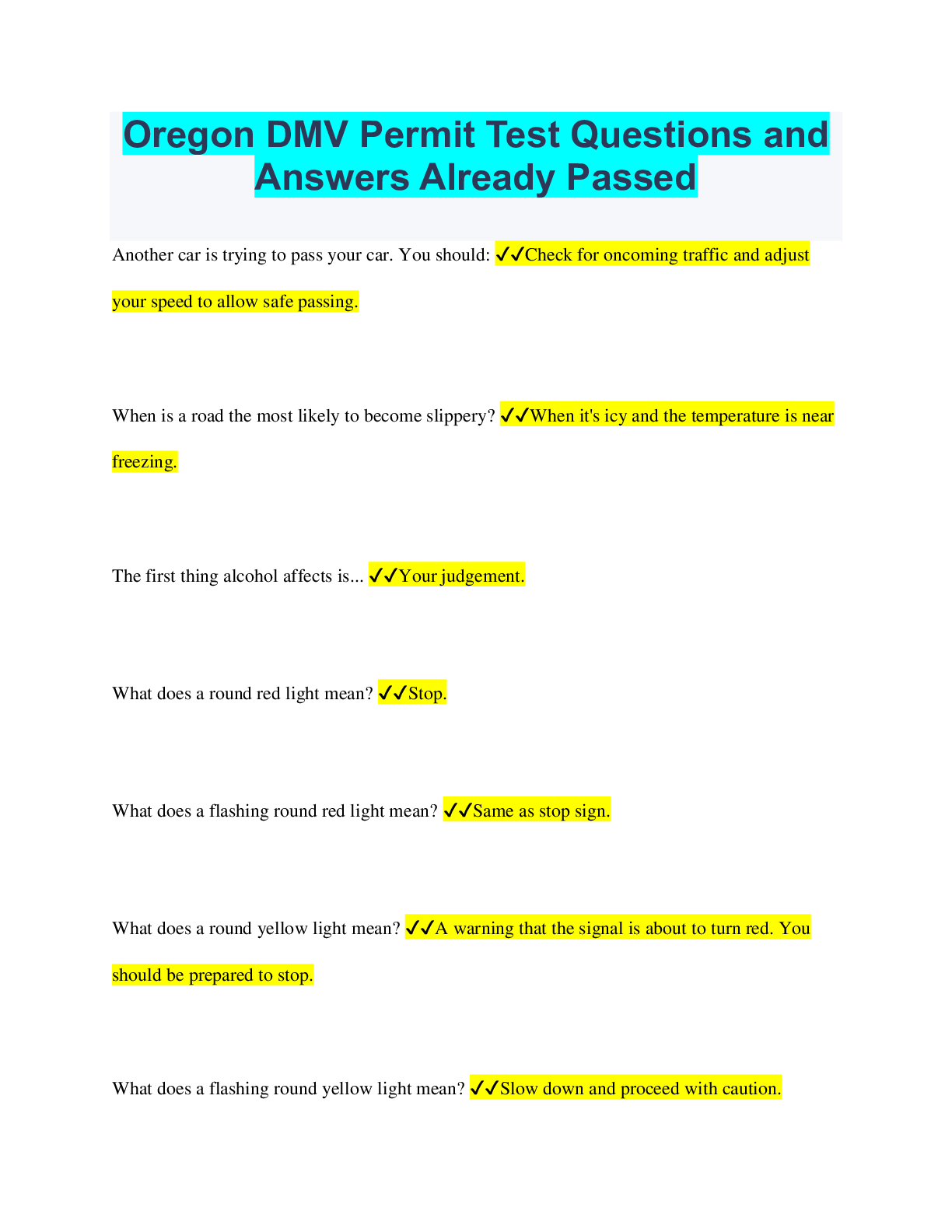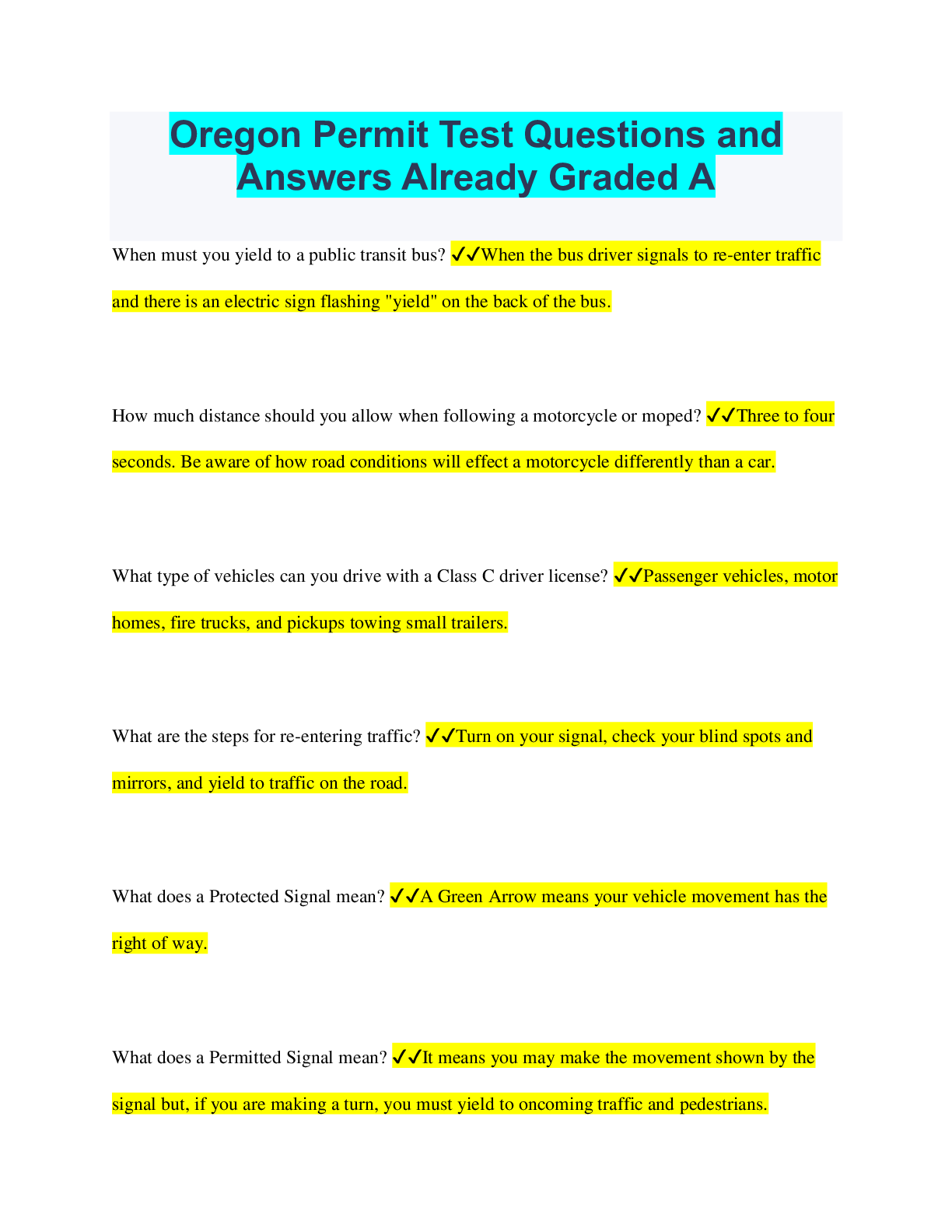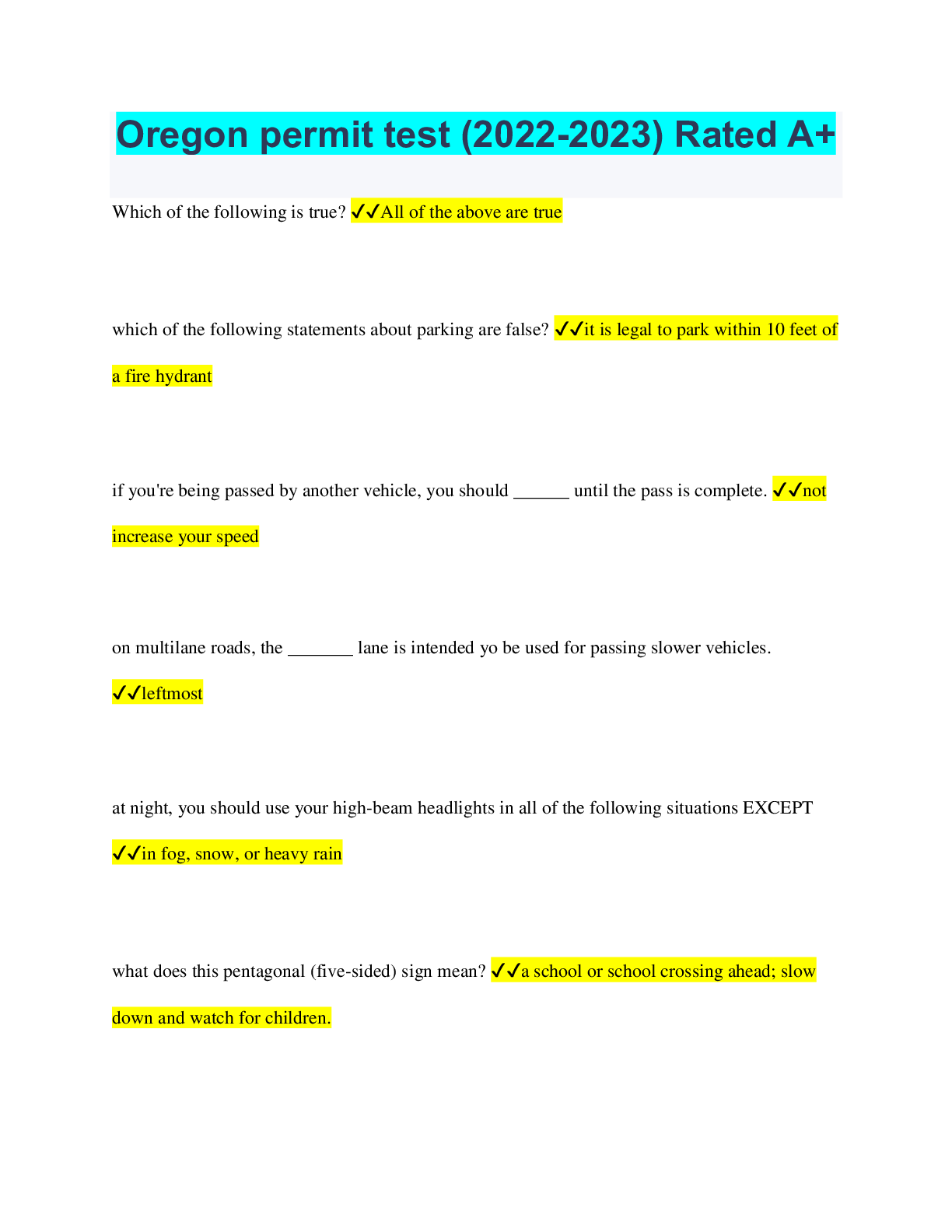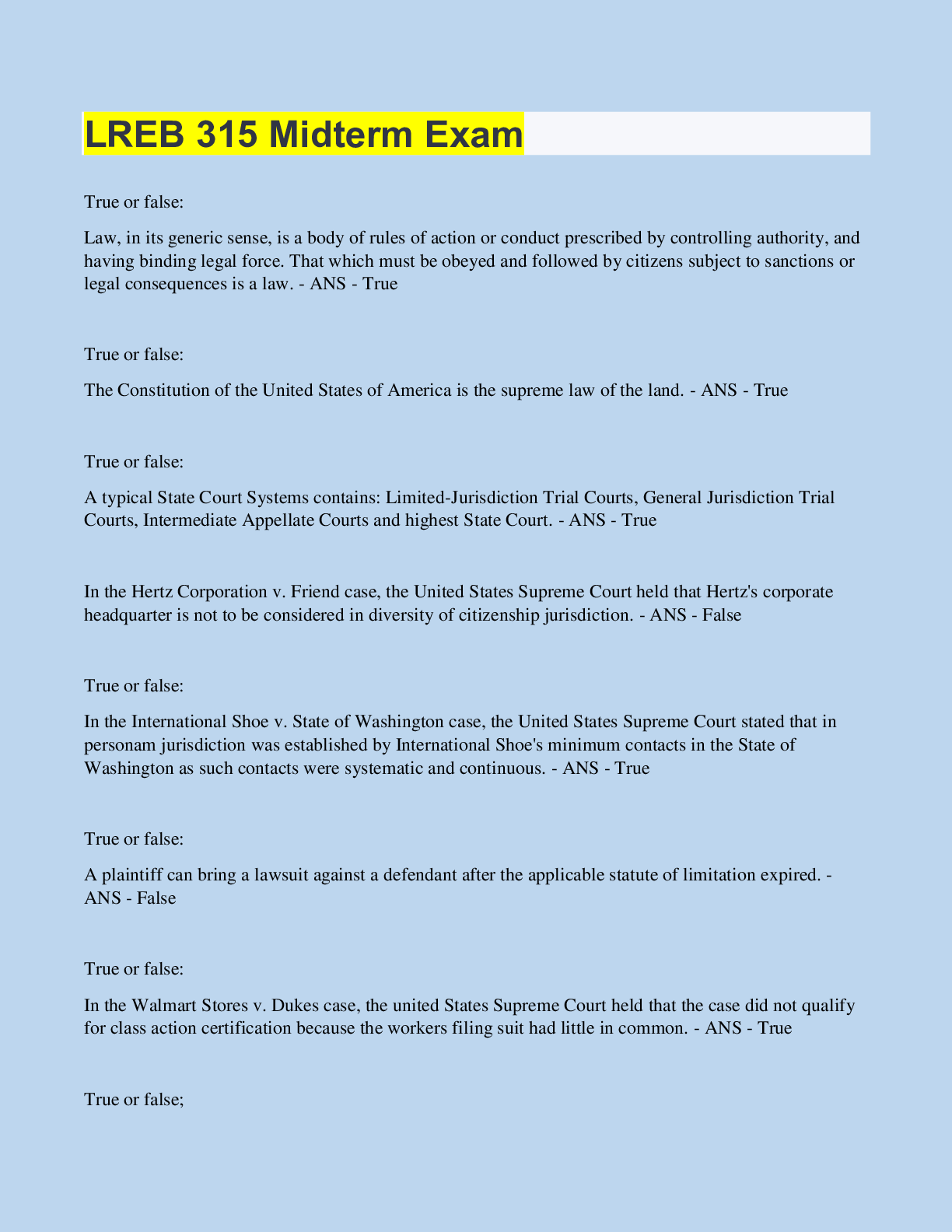Biology > QUESTIONS & ANSWERS > A2 AQA Biology Topic 5 Already Passed (All)
A2 AQA Biology Topic 5 Already Passed
Document Content and Description Below
A2 AQA Biology Topic 5 Already Passed Glucose C6H12O6 - a single sugar which is produced in photosynthesis. ATP An activated nucleotide found in all living organisms, which is produced during resp... iration and acts as an energy carrier. ATP is produced during the light-dependent reaction of photosynthesis. metabolism the chemical processes that occur within a living organism in order to maintain life. Photosynthesis A complex metabolic pathway involving many intermediate reactions. Some energy in light is conserved in the form of chemical bonds. There are three main stages: capturing the light energy, the light-dependent reaction and light-independent reaction. Photolysis Light energy splits 2 water molecules into 4 electrons, 4 hydrogen ions (protons) and an oxygen molecule (light-dependent reaction). These electrons replace the electrons lost from a chlorophyll molecule when light strikes it. Oxidation Loss of electrons or loss of hydrogen or gain of oxygen with a substance Reduction Gain of electrons or gain of hydrogen or loss of oxygen from a substance Co-enzyme A non-protein compound that is necessary for the functioning of an enzyme. (NOT AN ENZYME!) Play a huge role in photosynthesis and respiration where they carry hydrogen atoms from one molecule to another. E.g. NAD, FAD and NADP. NADP An electron carrier that is important in photosynthesis. When it takes up protons the NADP becomes reduced. NADPH Reduced NADP - it is the main produced of the light-dependent stage and it enters the lightindependent reaction taking with it the electrons from the chlorophyll molecules. Chloroplast The cellular organelles where photosynthesis takes place. Typically 2-10µm long and 1µm in diameter and are surrounded by a double membrane which inside it contains two distinct regions: the grana and stroma. Thylakoid Disc like structures which make up the grana in stacks of up to 100. Where the light-dependent stage of photosynthesis takes place. They contain the photosynthesis pigment chlorophyll. Some may have tubular extensions (intergranal lamellae) which join up with thylakoids in adjacent grana. Stroma Fluid-filled matrix where the light-independent stage of photosynthesis takes place. Chlorophyll Photosynthetic pigment inside thylakoids which absorbs light energy. Can become ionisied. Light-dependent reaction Stage of photosynthesis in which light energy is required to produce ATP and reduced NADP Photoionisation Process by which a chlorophyll molecule becomes ionised. Caused by the chlorophyll molecule absorbing light energy and boosting the energy of a pair of electrons within a chlorophyll molecule, raising them to a higher energy level and they become so energetic they leave the chlorophyll molecule altogether and are taken up by an electron carrier. Thylakoid membrane Contains a transfer chain where electrons are passed along a number of electron carriers in a series of oxidation-reduction reactions. Where chemiosmotic theory happens - ATP is made. Proton pumps A protein which actively transports protons into the thylakoid using energy from electrons from chlorophyll. They mean a concentration gradient of protons is maintained across the thylakoid membrane with a high concentration inside the thylakoid space a low concentration in the stroma. Electron transfer chain How electrons are passed along a number of electron carriers in a series of oxidation-reduction reactions. Each new carrier is at a slightly lower energy level than the previous one in the chain, and so the electrons lose energy at each stage, which is used to combine an inorganic phosphate molecule with an ADP molecule to make ATP. Chemiosmotic theory Mechanism by which ATP is produced in the light-dependent stage of photosynthesis. How it works is that protons are pumped from the stroma using proton pumps in the thylakoid membrane. The energy to drive this process comes from electrons released when photolysis of water happens. The photolysis of water also produces protons which further increase their concentration inside the thylakoid space. A concentration gradient of protons is therefore maintained across the thylakoid membrane with a higher concentration inside the thylakoid space and lower concentration in the stroma. Protons can only cross the thylakoid membrane through ATP synthase channel proteins and when they pass through they cause changes to the structure of the enzyme which then catalyses the combination of ADP with inorganic phosphate to form ATP. ATP synthase An enzyme which is embedded in the thylakoid membrane through which protons pass through and cause changes to the structure of the enzyme which then catalyses the combination of ADP with inorganic phosphate to form ATP. Light-independent reaction Stage of photosynthesis which does not require light energy directly, but does need the products of the light dependent reaction to reduce CO2 and form carbohydrate Calvin Cycle A biochemical pathway (part of the light-independent reaction) where CO2 is reduced to form carbohydrate. It takes 6 turns of the Calvin cycle (6 CO2, 18 ATP and 12 NADPH) to make one hexose sugar (because 1/6 molecules of TP are used to make useful substances e.g. glucose and 5/6 molecules of TP are used to make RuBP). 1 CO2 (1C) + 1 RuBP (5C) --> 2 GP (2 x 3C) + (2 NADPH + 2 ATP) --> 2 TP (2 x 3C) --> Glucose (6C) or RuBP (needs 1 ATP to make RuBP) (5C) Ribulose bisphosphate (RuBP) A 5 carbon sugar (in the Calvin cycle) which reacts with carbon dioxide in the stroma to produce two molecules of GP. This reaction is catalysed by rubisco (ribulose biphosphate caryboxylase). Glycerate 3 phosphate (GP) A 3 carbon acid (in the Calvin cycle) which reduced NADP is used to reduce to TP using energy supplied by ATP. Triose Phosphate (TP) A 3 carbon sugar (in the Calvin cycle) which can be converted to organic substances that the plant requires such as starch, cellulose, lipids, glucose, amino acids and nucleotides, but most are used to regenerate ribulose biphosphate using ATP from the light-dependent reaction. Limiting factor A variable that limits the rate of a chemical reaction Aerobic Requires glucose, oxygen and produces carbon dioxide, water and up to 38 molecules of ATP (2 from glycolysis, 2 from Krebs cycle and up to 34 from oxidative phosphorylation). Anaerobic Releasing energy from glucose without oxygen (produces lactate in animals and ethanol and carbon dioxide in plants and fungi) and 2 molecules of ATP. Glycolysis First part of cellular respiration in which glucose is broken down (in the cytoplasm). The overall yield of glycolysis is 2 molecules of ATP, 2 molecules of reduced NAD and 2 molecules of pyruvate. Phosphorylation Process which makes glucose more reactive by adding 2 phosphate molecules. Oxidation Loss of electrons or loss of hydrogen or gain of oxygen with a substance. Happens to the two triose phosphate molecules in glycolysis when hydrogen is removed. NAD A hydrogen carrier molecule which is important throughout respiration. FAD A hydrogen carrier molecule which is important in the Krebs cycle. Pyruvate 2 molecules of this are produced by glycolysis. If there is no oxygen present then it will be converted into either lactate or ethanol during anaerobic respiration. If oxygen is present it will be actively transported into the matrix of the mitochondria where it is oxidized to acetate. Link reaction Process linking Glycolysis to the Krebs Cycle (in the matrix of the mitochondria), where the 2 molecules of pyruvate are converted to CO2 and acetylcoenzyme A. 2 NAD molecules are reduced to form reduced NAD. Pyruvate + NAD + CoA --> acetyl CoA + reduced NAD + CO2 Acetyl coenzyme A Formed in the link reaction when coenzyme A combines with acetate (2C). Kreb's cycle A series of aerobic biochemical reactions in the matrix of mitochondria of most eukaryotic cells by which energy is obtained through introducing acetylcoenzyme A into a cycle of oxidationreduction reactions (in the matrix of the mitochondria). Acetyl CoA combines with a 4C molecule to produce a 6C molecule. This then loses 2 CO2 and hydrogen to give a 4C molecule and ATP due to substrate level phosphorylation. The 4C molecule then combines with acetyl CoA to continue the cycle. Per glucose molecule it produces 2 molecules of ATP and 6 reduced NAD and 2 reduced FAD. 2 acetyl CoA + 6NAD+ + 2FAD + 2ADP + 2H3PO4 --> 4CO2 + 6 NADH + 6H+ + 2FADH2 + 2ATP Substrate level phosphorylation Happens in plant and animal cells when phosphate groups are transferred from donor molecules to ADP to form ATP. Oxidative phosphorylation The formation of ATP in the electron transport system of aerobic respiration. Happens in the mitochondria within the inner folded membrane (cristae). It involves the transfer of electrons down a series of electron carrier molecules which form an electron transfer chain. Electron transfer chain Use of electrons from the Krebs Cycle to synthesise ATP via a series of oxidation-reduction reactions. As electrons pass along a chain of electron transfer carrier molecules in a series of oxidation-reduction reactions, the electrons release energy which causes the active transport of protons across the inner mitochondrial membrane and into inter-membranal space. The oxygen is the final acceptor of electrons in the electron transfer chain. ATP Synthase An enzyme which is embedded in the inner membrane of the mitochondria through which protons pass through and cause changes to the structure of the enzyme which then catalyses the combination of ADP with inorganic phosphate to form ATP. Chemiosmosis Theory of oxidative phosphorylation. As electrons flow along the chain, they release energy which causes the active transport of protons across the inner mitochondrial membrane which means a concentration gradient of protons is maintained with a higher concentration of protons in the inter-membranal space than in the mitochondrial matrix. They then diffuse back into the mitochondrial matrix through ATP synthase channels which forms ATP. Proton pump A protein which actively transports protons into the inter-membranal space using energy from the energy released by electrons as they flow along the chain. They mean a concentration gradient of protons is maintained across the inner mitochondrial membrane with a high concentration in the inter-membranal space and a lower concentration in the mitochondrial matrix. Electron acceptor Oxygen acts as the final acceptor of electrons in the electron transfer chain. Oxidation-reduction A chemical reaction in which electrons are transferred from one substance to another substance. The substance losing electrons is oxidized and the substance gaining the electrons is reduced. Biomass The total mass of living material in a specific area at a given time. Usually measured in gm-2. Fresh mass is quite easy to assess, but varies depending on the water content. Measuring dry mass overcomes this problem but the organism must be killed, it is usually only a small sample and may not be representative. Calorimetry The chemical energy store in a dry mass can be estimated using this technique. When a sample of dry material is weighed and then burnt in pure oxygen within a sealed container (bomb). The bomb is surrounded by a water bath and the heat of combustion causes a temperature rise. This can be used to work out the energy released from the mass of burnt biomass. Producer Photosynthetic organism that manufacture organic substances using light energy, water, carbon dioxide and mineral ions. Consumer An organism that obtains its energy by feeding on (consuming) other organisms. Primary consumers eat producers. Secondary consumers eat primary consumers. Tertiary consumers eat secondary consumers. Extracellular digestion When saprobionts release enzymes externally which break down large biological molecules into smaller ones which are then absorbed by digestion or active transport. Trophic level Each stage in a food chain GPP Gross primary production which is the total quantity of the chemical energy store in plant biomass, in a given time. Plants use 20-50% of this energy in respiration. NPP Gross primary production - respiratory losses. The chemical energy store which is left when these losses to respiration have been taken into account. This is available for plant growth and reproduction and available to other trophic levels in the ecosystem (such as consumers and decomposers). Respiratory losses Taken away from GPP to calculate NPP. Food chain Describes a feeding relationship in which the producers are eaten by primary consumers, which are eaten by secondary consumers, which are then eaten by tertiary consumers. These could then be eaten by quarternary consumers. Each stage is referred to a trophic level. Food web How food chains link together in a habitat to form a food web. Pyramid of Number A pyramid drawn with bar lengths proportional to the numbers of organisms present Pyramid of Biomass A pyramid drawn with bar lengths proportional to the mass of plants/animals Pyramid of Energy A pyramid drawn with bar lengths proportional to the energy stored in organisms Productivity The rate of generation of biomass in an ecosystem. Usually measured in units of mass per area put unit time (gm-2y-1). Farming practices try to improve this by increasing yields by increasing the efficiency of energy transfer along the food chains which produce our food. Intensive farming A type of farming which uses processes, such as using confined spaces to restrict movement, keeping the environment warm and excluding predators, to try and make energy conversion more efficient by ensuring that as much energy from respiration as possible goes into growth rather than other activities or other organisms. Percentage efficiency Can be calculated by dividing the energy available after the transfer by energy available before the transfer x 100. Biological control Controlling pests by introducing predators Selective breeding Breeding of organisms by human selection of parents for certain characteristics Ecosystem All the living and non-living components of a particular area. Saprobiontic microorganism Also known as saprophyte - an organism that obtains its food from the dead or decaying remains (detritus) of other organisms. Detritivores Organisms that help saprophytes do their job. They feed on pieces of dead and decaying material and finely break it up increasing its surface area. Decomposer Any organism which breaks down organic matter. Include saprophytes and detritivores. Nitrogen cycle Four main stages: ammonification, nitrification, nitrogen fixation and denitrification. This is because all living organisms require a source of nitrogen from which to manufacture proteins, nucleic acids and other nitrogen-containing compounds. Nitrogen fixation Conversion of nitrogen gas into nitrogen-containing compounds. Carried out by free-living nitrogen fixing bacteria and mutualistic nitrogen-fixing bacteria which live in nodules on the roots of plants such as peas and beans. It can also be carried out industrially and occurs naturally when lightning passes through the atmosphere. Nitrogen fixing bacteria Carry out the process of nitrogen fixation. Can be free-living or mutualistic bacteria. Ammonification Production of ammonia from organic nitrogen-containing compounds e.g. urea and proteins. Saprobiontic microorganisms feed on faeces and dead organisms materials, releasing ammonia which then forms ammonium ions in the soil. Nitrification Carried out by free-living nitrifying bacteria. Some convert ammonia into nitrites and some convert nitrites into nitrates using oxidation reactions which release energy. Good drainage and ploughing prevents air spaces from being filled with water and allows nitrification to continue. Denitrification Carried out by anaerobic denitrifying bacteria which convert of soil nitrates into nitrogen gas. Phosphorous cycle Enables the cycling of phosphorous which is an important biological element as it is a component of ATP, phospholipids and nucleic acids. There is no gaseous phase in the phosphorous cycle. Phosphate PO43- ions are how phosphorous exists mostly in the form of sedimentary rock deposits. Weathering How rocks are worn away - how phosphate ions in wastes and remains e.g. guano, bones and shells and in rocks are released into oceans, lakes and soils as dissolved phosphate ions. Mycorrhizae Mutualistic association between certain types of fungi and the vast majority of plants. The fungi act like extensions of the plant's root system and increase the surface area for absorption of water and minerals. The fungi receives organic compounds such as sugars and amino acids from the plant. The mycorrhiza act like a sponge and so holds water and minerals in the neighbourhood of the roots, enabling the plant to better resist drought and take up inorganic ions more readily. They improve the uptake of relatively scarce ions such as phosphate ions. Guano The excrement of seabirds and bats. Symbiotic When two species live in close proximity. Mutualistic is a type of symbiotic relationship where the relationship is mutually beneficial for two organisms. Fertiliser Using these replenishes mineral ions, especially nitrates. They are necessary to improve productivity because in agriculture crops are harvested and mineral ions are not returned to the soil by decomposition by microorganisms, like would normally happen. They increase productivity because they provide minerals such as nitrogen for plants to build proteins, ATP and DNA nucleotides. Inorganic Type of fertiliser which are mined from rocks and deposits and then converted into different forms and blended together to give the appropriate balance of minerals for a particular crop. Contain nitrogen, phosphorous and potassium. Organic Type of fertiliser which consist of the dead and decaying remains of plants and animals as well as animal wastes such as manure, slurry and bone meal. Leaching Process by which nutrients are washed from the soil into watercourses. Rainwater will dissolve any soluble nutrients, such as nitrate ions and carry them deep into the soil, eventually beyond the reach of plant roots. Eutrophication Consequence of an increase in nutrient concentrations in watercourses that leads to an algal bloom, leading to light being the limiting factor for the growth of plants and algae at lower depths, leading to saprobiontic bacteria creating an increased demand for oxygen. This leads to aerobic organisms dying and anaerobic organisms populations rising. It leads to a decrease in biodiversity. Greenhouse gases Gases such as methane and CO2 which trap more heat energy, raising the Earth [Show More]
Last updated: 2 years ago
Preview 1 out of 26 pages
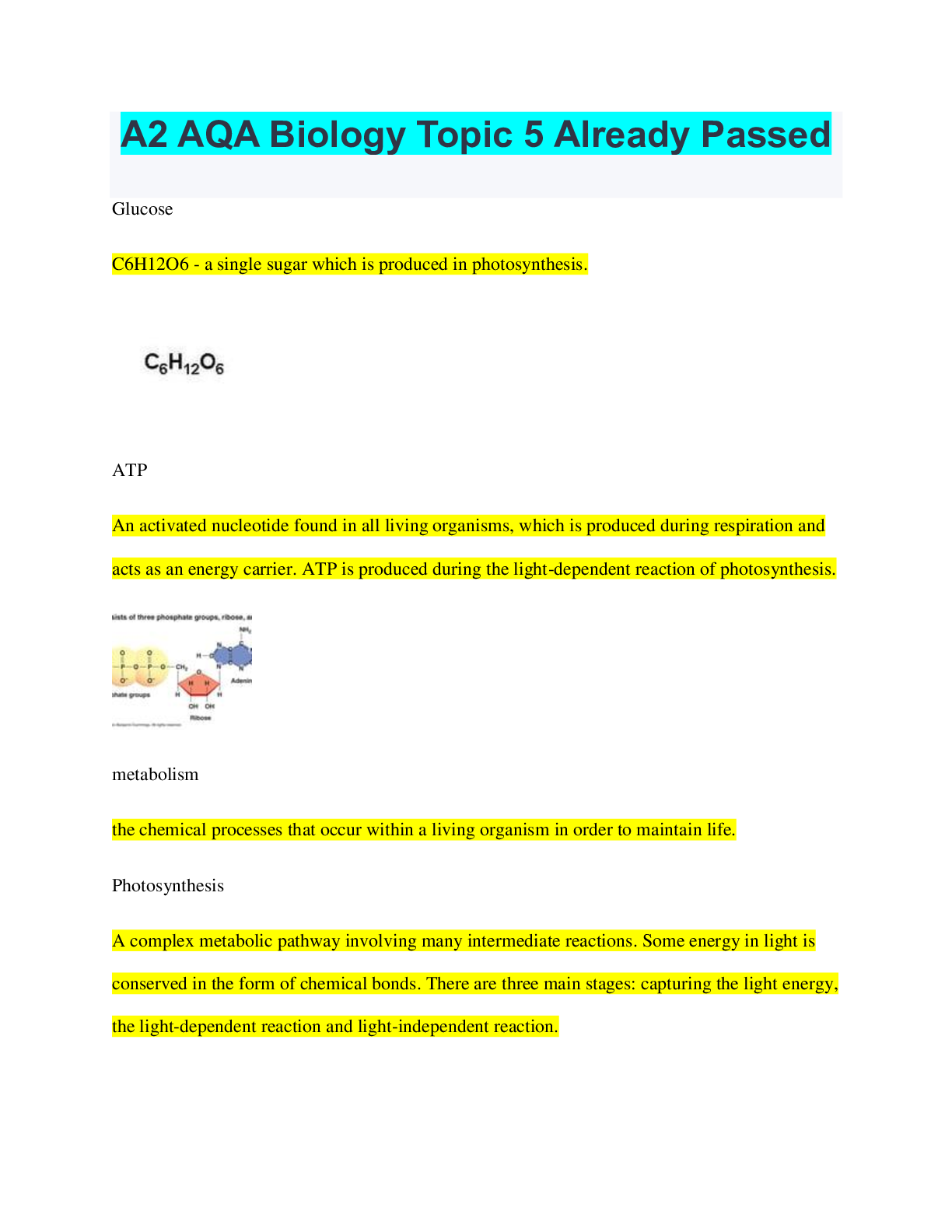
Buy this document to get the full access instantly
Instant Download Access after purchase
Buy NowInstant download
We Accept:

Also available in bundle (1)

AQA A-Level Biology Bundled Exams Questions and Answers with Verified Solutions
AQA A-Level Biology Bundled Exams Questions and Answers with Verified Solutions
By Nutmegs 2 years ago
$23
21
Reviews( 0 )
$10.00
Can't find what you want? Try our AI powered Search
Document information
Connected school, study & course
About the document
Uploaded On
Apr 29, 2023
Number of pages
26
Written in
Additional information
This document has been written for:
Uploaded
Apr 29, 2023
Downloads
0
Views
132

.png)


